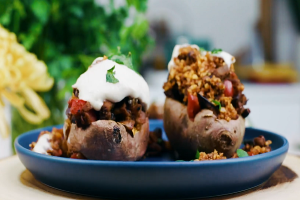EUROPE
European Vegan Recipes: Tradition and Innovation in Plant-Based Cuisine
European cuisine, with its rich history and diverse culinary traditions, has seen a remarkable evolution in recent years as veganism has gained popularity across the continent. From the Mediterranean’s fresh, vegetable-focused dishes to Northern Europe’s innovative plant-based takes on classic comfort foods, European vegan recipes offer a delicious journey through a variety of flavors and textures. In this column, we explore the vibrant world of European vegan cuisine, highlighting both traditional and modern interpretations of plant-based eating.
Mediterranean Vegan Cuisine: A Celebration of Freshness and Flavor
The Mediterranean diet, often celebrated for its health benefits, naturally lends itself to vegan adaptations. Countries like Italy, Greece, and Spain offer a wealth of plant-based dishes that are as satisfying as they are nutritious. Italian cuisine, for instance, is known for its use of fresh, high-quality ingredients. Classic dishes like pasta al pomodoro (pasta with tomato sauce) and bruschetta (grilled bread with tomato and basil) are naturally vegan, relying on simple ingredients to create bold flavors.
In Greece, the emphasis on vegetables, legumes, and olive oil forms the basis of many traditional vegan dishes. Fasolada, a hearty bean soup, and horiatiki (Greek salad) made with ripe tomatoes, cucumbers, olives, and onions, are staples of the Greek vegan diet. The use of fresh herbs like oregano, mint, and dill adds depth to these dishes, making them both flavorful and refreshing.
Spanish cuisine also offers a variety of vegan options, particularly in the form of tapas. Dishes like patatas bravas (spicy potatoes), escalivada (roasted vegetables), and gazpacho (cold tomato soup) showcase the vibrant flavors of Spain’s fresh produce. These small plates are perfect for sharing and provide a delightful introduction to the diversity of Mediterranean vegan cuisine.
Northern European Vegan Cuisine: Reinventing Comfort Food
In Northern Europe, where hearty and filling dishes are the norm, the vegan movement has inspired creative reinterpretations of traditional comfort foods. Germany, Sweden, and the UK are leading the way in developing plant-based versions of classic dishes, using innovative ingredients and cooking techniques.
In Germany, for example, vegan schnitzel made from seitan or soy is a popular alternative to the traditional meat-based version. Served with a side of potato salad or braised red cabbage, it offers the same satisfying experience with a plant-based twist. Similarly, Swedish meatballs, traditionally made with pork or beef, can be veganized using lentils or mushrooms, providing a delicious and hearty meal that aligns with the Scandinavian commitment to sustainability and local sourcing.
The UK has also embraced veganism with enthusiasm, particularly in its approach to classic British dishes. Vegan shepherd’s pie, made with lentils, vegetables, and topped with creamy mashed potatoes, is a comforting and nutritious alternative to the meat-based original. The rise of veganism in the UK has also led to a boom in plant-based options for traditional English breakfasts, with vegan sausages, baked beans, grilled tomatoes, and mushrooms forming a hearty start to the day.
Eastern European Vegan Cuisine: Hearty and Wholesome
Eastern Europe, with its cold winters and emphasis on hearty, warming dishes, might not seem like an obvious place for vegan cuisine, but it offers a surprising array of plant-based options. Poland, Ukraine, and Russia have rich culinary traditions that include a variety of vegan-friendly dishes.
In Poland, pierogi (dumplings) filled with potatoes and onions are a beloved comfort food that can easily be made vegan. Served with sautéed onions and a side of sauerkraut, they provide a filling and flavorful meal. Borscht, a vibrant beet soup, is another Eastern European staple that is naturally vegan. This tangy, slightly sweet soup is typically served with a dollop of vegan sour cream and fresh dill.
Ukrainian cuisine also features dishes like kapusta (braised cabbage) and varenyky (dumplings similar to pierogi), which can be stuffed with mushrooms, potatoes, or fruit for a sweet version. The reliance on root vegetables, grains, and legumes in Eastern European cooking makes it easy to adapt many traditional recipes into satisfying vegan meals.
Conclusion: Discovering the Diversity of European Vegan Cuisine
European vegan recipes offer a delightful blend of tradition and innovation, bringing together the best of the continent’s culinary heritage with a modern plant-based approach. From the fresh and vibrant flavors of the Mediterranean to the hearty comfort foods of Northern and Eastern Europe, there is a wealth of vegan options to explore and enjoy. Whether you’re seeking to recreate classic dishes in a vegan-friendly way or discover new and exciting flavors, European vegan cuisine has something to offer every palate. As the vegan movement continues to grow, so too will the diversity and creativity of European plant-based cooking.








